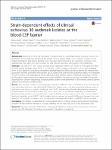Strain-dependent effects of clinical echovirus 30 outbreak isolates at the blood-CSF barrier
Dahm, Tobias
Adams, Ortwin
Boettcher, Sindy
Diedrich, Sabine
Morozov, Vasily
Hansman, Grant
Fallier-Becker, Petra
Schädler, Sebastian
Burkhardt, Claus J.
Weiss, Christel
Stump-Guthier, Carolin
Ishikawa, Hiroshi
Schroten, Horst
Schwerk, Christian
Tenenbaum, Tobias
Rudolph, Henriette
Background: Echovirus (E) 30 (E-30) meningitis is characterized by neuroinflammation involving immune cell pleocytosis at the protective barriers of the central nervous system (CNS). In this context, infection of the blood-cerebrospinal fluid barrier (BCSFB), which has been demonstrated to be involved in enteroviral CNS pathogenesis, may affect the tight junction (TJ) and adherens junction (AJ) function and morphology. Methods: We used an in vitro human choroid plexus epithelial (HIBCPP) cell model to investigate the effect of three clinical outbreak strains (13-311, 13-759, and 14-397) isolated in Germany in 2013, and compared them to E-30 Bastianni. Conducting transepithelial electrical resistance (TEER), paracellular dextran flux measurement, quantitative real-time polymerase chain reaction (qPCR), western blot, and immunofluorescence analysis, we investigated TJ and AJ function and morphology as well as strain-specific E-30 infection patterns. Additionally, transmission electron and focused ion beam microscopy electron microscopy (FIB-SEM) was used to evaluate the mode of leukocyte transmigration. Genome sequencing and phylogenetic analyses were performed to discriminate potential genetic differences among the outbreak strains. Results: We observed a significant strain-dependent decrease in TEER with strains E-30 Bastianni and 13-311, whereas paracellular dextran flux was only affected by E-30 Bastianni. Despite strong similarities among the outbreak strains in replication characteristics and particle distribution, strain 13-311 was the only outbreak isolate revealing comparable disruptive effects on TJ (Zonula Occludens (ZO) 1 and occludin) and AJ (E-cadherin) morphology to E-30 Bastianni. Notwithstanding significant junctional alterations upon E-30 infection, we observed both para- and transcellular leukocyte migration across HIBCPP cells. Complete genome sequencing revealed differences between the strains analyzed, but no explicit correlation with the observed strain-dependent effects on HIBCPP cells was possible. Conclusion: The findings revealed distinct E-30 strain-specific effects on barrier integrity and junctional morphology. Despite E-30-induced barrier alterations leukocyte trafficking did not exclusively occur via the paracellular route.
Dateien zu dieser Publikation
Keine Lizenzangabe

